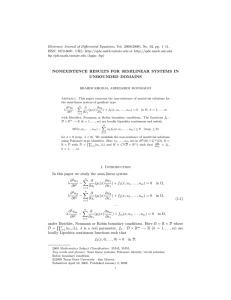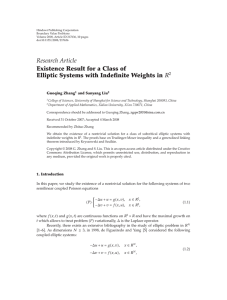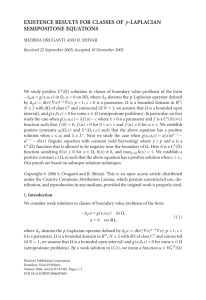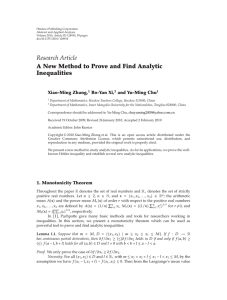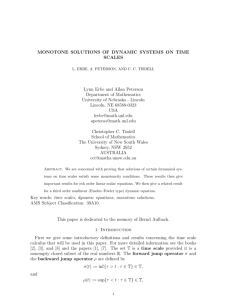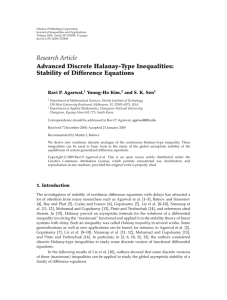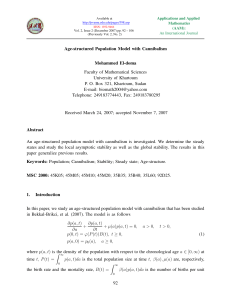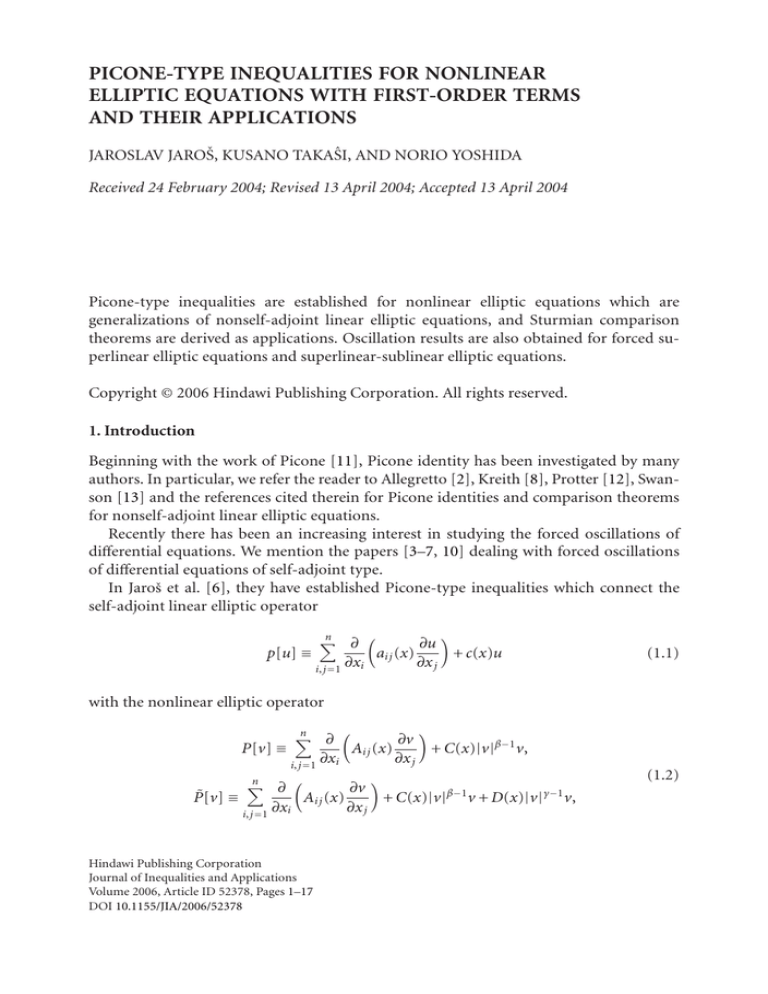
PICONE-TYPE INEQUALITIES FOR NONLINEAR
ELLIPTIC EQUATIONS WITH FIRST-ORDER TERMS
AND THEIR APPLICATIONS
JAROSLAV JAROŠ, KUSANO TAKAŜI, AND NORIO YOSHIDA
Received 24 February 2004; Revised 13 April 2004; Accepted 13 April 2004
Picone-type inequalities are established for nonlinear elliptic equations which are
generalizations of nonself-adjoint linear elliptic equations, and Sturmian comparison
theorems are derived as applications. Oscillation results are also obtained for forced superlinear elliptic equations and superlinear-sublinear elliptic equations.
Copyright © 2006 Hindawi Publishing Corporation. All rights reserved.
1. Introduction
Beginning with the work of Picone [11], Picone identity has been investigated by many
authors. In particular, we refer the reader to Allegretto [2], Kreith [8], Protter [12], Swanson [13] and the references cited therein for Picone identities and comparison theorems
for nonself-adjoint linear elliptic equations.
Recently there has been an increasing interest in studying the forced oscillations of
differential equations. We mention the papers [3–7, 10] dealing with forced oscillations
of differential equations of self-adjoint type.
In Jaroš et al. [6], they have established Picone-type inequalities which connect the
self-adjoint linear elliptic operator
n
∂
p[u] ≡
i, j =1
∂xi
ai j (x)
∂u
+ c(x)u
∂x j
(1.1)
with the nonlinear elliptic operator
P[v] ≡
n
∂
i, j =1
n
∂
∂xi
Ai j (x)
∂v
+ C(x)|v|β−1 v,
∂x j
∂v
Ai j (x)
+ C(x)|v|β−1 v + D(x)|v|γ−1 v,
P̃[v] ≡
∂x
∂x
i
j
i, j =1
Hindawi Publishing Corporation
Journal of Inequalities and Applications
Volume 2006, Article ID 52378, Pages 1–17
DOI 10.1155/JIA/2006/52378
(1.2)
2
Picone-type inequalities
where β and γ are positive constants with β > 1 and 0 < γ < 1. They have derived Sturmian
comparison theorems and oscillation theorems for the forced elliptic equation
P[v] = f (x)
(1.3)
as well as the superlinear-sublinear elliptic equation
P̃[v] = 0.
(1.4)
The objective of this paper is to extend the results obtained in [6] to the nonlinear
elliptic equations with first-order terms
L[v] = f (x),
(1.5)
L̃[v] = 0,
(1.6)
where
n
∂
L[v] ≡
i, j =1
L̃[v] ≡
n
∂
i, j =1
∂xi
∂xi
Ai j (x)
Ai j (x)
∂v
∂v
+ 2 Bi (x)
+ C(x)|v|β−1 v,
∂x j
∂x
i
i =1
n
∂v
∂v
+ 2 Bi (x)
+ C(x)|v|β−1 v + D(x)|v|γ−1 v.
∂x j
∂x
i
i=1
n
(1.7)
We note that if there exists a C 1 -function F(x) such that
−1
∇F(x) = 2B(x) Ai j (x) ,
(1.8)
where B(x) = (B1 (x),B2 (x),...,Bn (x)), then (1.5) can be written in the form
n
∂
i, j =1
∂xi
eF(x) Ai j (x)
∂v
+ eF(x) C(x)|v|β−1 v = eF(x) f (x),
∂x j
(1.9)
which was studied in [6].
In Section 2 we establish Picone-type inequalities for (1.5), and in Section 3 we obtain
oscillation theorems for (1.5) in an unbounded domain Ω ⊂ Rn . Sections 4 and 5 concern
Sturmian comparison theorems and oscillation theorems for (1.6), respectively.
2. Sturmian comparison theorems for (1.5)
Let G be a bounded domain in Rn with piecewise smooth boundary ∂G. It is assumed
that
(A1 ) Ai j (x) ∈ C(G; R), Bi (x) ∈ C(G; R), C(x) ∈ C(G;[0, ∞)) and f (x) ∈ C(G; R);
(A2 ) the matrix (Ai j (x)) is symmetric and positive definite in G;
(A3 ) β > 1.
The domain ᏰL (G) of L is defined to be the set of all functions v of class C 1 (G; R) with
the property that Ai j (x)(∂v/∂x j ) ∈ C 1 (G; R) ∩ C(G; R) (i, j = 1,2,...,n).
Jaroslav Jaroš et al. 3
Theorem 2.1. If v ∈ ᏰL (G), v = 0 in G and v · f (x) ≤ 0 in G, then the following inequality
holds for any u ∈ C 1 (G; R):
n
Ai j (x) v
i, j =1
∂ u
Bk (x)Aki (x)u
−
∂xi v
k =1
n
n
∂ u2
+
i, j =1
∂xi
n
Ai j (x)
v
v
∂v
∂x j
∂u Ai j (x)
−
Bk (x)Aki (x)u
≤
∂xi k=1
i, j =1
n
∂ u
Bk (x)Ak j (x)u
−
∂x j v
k =1
n
∂u −
Bk (x)Ak j (x)u
∂x j k=1
n
(2.1)
(β−1)/β 2 u2 − β(β − 1)(1−β)/β C(x)1/β f (x)
u +
L[v] − f (x) ,
v
where (Ai j (x)) = (Ai j (x))−1 .
Proof. The following Picone-type inequality was established by Jaroš et al. [6]:
n
Ai j (x) v
i, j =1
≤
n
∂ u
∂xi v
Ai j (x)
i, j =1
u2
+
v
v
∂ u
∂x j v
+
n
∂ u2
i, j =1
∂xi
v
Ai j (x)
∂v
∂x j
(β−1)/β 2
∂u ∂u
− β(β − 1)(1−β)/β C(x)1/β f (x)
u
∂xi ∂x j
n
∂
(2.2)
∂v
Ai j (x)
+ C(x)|v|β−1 v − f (x) .
∂x
∂x
i
j
i, j =1
Since
−2u
n
Bi (x)v
i=1
∂ u
∂u
u2 ∂v
+2
Bi (x) ,
= −2u Bi (x)
∂xi v
∂x
v
∂x
i
i
i =1
i =1
n
n
(2.3)
combining (2.2) with (2.3) yields
n
Ai j (x) v
i, j =1
∂ u
∂xi v
+ B(x) Ai j (x)
v
−1
∂ u
∂x j v
B(x)T u2 +
− 2u
n
i, j =1
Bi (x)v
i=1
n
∂ u2
i, j =1
≤
n
∂xi
v
Ai j (x)
v
∂v
∂x j
−1
∂u ∂u
∂u
− 2u Bi (x)
+ B(x) Ai j (x) B(x)T u2
∂xi ∂x j
∂x
i
i =1
n
Ai j (x)
(β−1)/β 2
− β(β − 1)(1−β)/β C(x)1/β f (x)
u
n
n
u2 ∂
∂v
∂v
+
∂ u
∂xi v
i, j =1
∂xi
Ai j (x)
∂x j
Bi (x)
+2
i=1
∂xi
(2.4)
β −1
+ C(x)|v|
v − f (x) ,
4
Picone-type inequalities
where B(x) = (B1 (x),...,Bn (x)) and the superscript T denotes the transpose. In view of
the identities
n
Ai j (x) v
i, j =1
∂ u
∂xi v
+ B(x) Ai j (x)
−1
n
v
∂ u
∂x j v
− 2u
n
Bi (x)v
i =1
B(x)T u2
∂ u
=
Ai j (x) v
Bk (x)Aki (x)u
−
∂x
v
i
i, j =1
k =1
× v
n
n
∂ u
∂xi v
(2.5)
∂ u
Bk (x)Ak j (x)u ,
−
∂x j v
k =1
n
−1
∂u ∂u
∂u
− 2u Bi (x)
+ B(x) Ai j (x) B(x)T u2
∂xi ∂x j
∂x
i
i =1
n
Ai j (x)
i, j =1
n
∂u =
Ai j (x)
−
Bk (x)Aki (x)u
∂x
i
i, j =1
k =1
n
∂u −
Bk (x)Ak j (x)u ,
∂x j k=1
n
(2.6)
we observe that (2.4) is equivalent to (2.1).
We consider the comparison operator
[u] ≡
n
∂
i, j =1
∂xi
ai j (x)
∂u
∂u
+ 2 bi (x)
+ c(x)u,
∂x j
∂x
i
i =1
n
(2.7)
where the coefficients ai j (x), bi (x), c(x) satisfy the following hypotheses:
(A4 ) ai j (x), bi (x), c(x) ∈ C(G; R);
(A5 ) the matrix (ai j (x)) is symmetric and positive definite in G.
The domain Ᏸ (G) of is defined to be the set of all functions u of class C 1 (G; R) with
the property that ai j (x)(∂u/∂x j ) ∈ C 1 (G; R) ∩ C(G; R) (i, j = 1,2,...,n).
Theorem 2.2. Assume that u ∈ Ᏸ (G), v ∈ ᏰL (G), v = 0 in G and v · f (x) ≤ 0 in G. Then
we have the following Picone-type inequality
n
∂
∂u u2
∂v
uai j (x)
− Ai j (x)
∂x
∂x
v
∂x
i
j
j
i, j =1
≥
n
ai j (x) − Ai j (x)
i, j =1
∂u ∂u
∂xi ∂x j
− 2u
n
bi (x) − Bi (x)
i=1
∂u
∂xi
(β−1)/β
+ β(β − 1)(1−β)/β C(x)1/β f (x)
− c(x) − B(x) Ai j (x) B(x)T u2
n
n
n
∂ u
∂ u
+
Ai j (x) v
Bk (x)Aki (x)u v
Bk (x)Ak j (x)u
−
−
i, j =1
∂xi v
k =1
u
+ v[u] − u L[v] − f (x) .
v
∂x j v
k =1
(2.8)
Jaroslav Jaroš et al. 5
Proof. To prove the theorem it suffices to combine the inequalities (2.4) and (2.5) with
the identity
u[u] =
n
∂
i, j =1
∂xi
uai j (x)
∂u
∂u ∂u
∂u
ai j (x)
+ 2u bi (x)
+ c(x)u2 .
−
∂x j
∂x
∂x
∂x
i
j
i
i, j =1
i =1
n
n
(2.9)
Now we consider the first-order partial differential system
∇w − P(x)w = 0,
(2.10)
where P(x) = (P1 (x),P2 (x),...,Pn (x)) is a continuous vector function, and define the sequence of functions {qk (x)}nk=1 by
qk (x) = qk−1 (x) +
q1 (x) = P1 (x)dx1 ,
Pk (x) −
∂
qk−1 (x) dxk
∂xk
(2.11)
(k = 2,3,...,n).
Lemma 2.3. The system (2.10) has a C 1 -solution if and only if
∂
∂
Pk (x) −
qk−1 (x) = 0 (k = 2,3,...,n).
∂xk−1
∂xk
(2.12)
Then any C 1 -solution w of (2.10) can be written in the form
w = Cn exp qn (x)
(2.13)
for some constant Cn .
Proof. Suppose that (2.10) has a C 1 -solution w. Then we obtain
∂w
− P1 (x)w = 0,
∂x1
(2.14)
and hence
w = C1 x2 ,...,xn exp P1 (x)dx1 = C1 x2 ,...,xn exp q1 (x)
(2.15)
for some function C1 (x2 ,...,xn ). From
∂w
− P2 (x)w = 0
∂x2
(2.16)
we see that C1 (x2 ,...,xn ) must satisfy
∂C1
∂
− P2 (x) −
∂x2
∂x2
P1 (x)dx1 C1 = 0.
(2.17)
6
Picone-type inequalities
Hence, it is necessary that
∂
∂
P2 (x) −
∂x1
∂x2
P1 (x)dx1 = 0,
(2.18)
and we have
C1 = C2 x3 ,...,xn exp
P2 (x) −
∂
∂x2
P1 (x)dx1 dx2
(2.19)
for some function C2 (x3 ,...,xn ), and therefore
w = C2 x3 ,...,xn exp
P1 (x)dx1 +
∂
∂x2
P2 (x) −
= C2 x3 ,...,xn exp q2 (x).
P1 (x)dx1 dx2
(2.20)
Repeating this procedure, we observe that (2.12) is necessary and the solution w has the
form (2.13). From the above consideration it is obvious that the condition (2.12) is suffi
cient for (2.10) to have a C 1 -solution.
Theorem 2.4. If there exists a nontrivial function u ∈ C 1 (G; R) such that u = 0 on ∂G and
M[u] ≡
n
G
Ai j (x)
i, j =1
− β(β − 1)
∂u −
Bk (x)Aki (x)u
∂xi k=1
n
(1−β)/β
C(x)
1/β ∂u −
Bk (x)Ak j (x)u
∂x j k=1
n
(β−1)/β 2
f (x)
u dx ≤ 0,
(2.21)
then every solution v ∈ ᏰL (G) of (1.5) satisfying v · f (x) ≤ 0 in G vanishes at some point
of G. Furthermore, if ∂G ∈ C 1 , then either every solution v ∈ ᏰL (G) of (1.5) satisfying v ·
f (x) ≤ 0 in G has a zero in G or else u = C0 v exp q(x) for some nonzero constant C0 and
some continuous function q(x).
Proof
The first statement. Suppose to the contrary that there exists a solution v ∈ ᏰL (G) of
(1.5) satisfying v · f (x) ≤ 0 in G and v = 0 on G. We find that the inequality (2.1) of
Theorem 2.1 holds. Integrating (2.1) over G and then using the divergence theorem yield
M[u] ≥
n
G i, j =1
Ai j (x) v
∂ u
Bk (x)Aki (x)u
−
∂xi v
k =1
n
∂ u
× v
Bk (x)Ak j (x)u dx.
−
∂x j v
k =1
n
(2.22)
If
v
∂ u
Bk (x)Aki (x)u ≡ 0 in G (i = 1,2,...,n),
−
∂xi v
k =1
n
(2.23)
Jaroslav Jaroš et al. 7
then it follows from Lemma 2.3 that
u
= C0 exp q(x)
v
(2.24)
in G, by continuity on G, where C0 is some constant and q(x) is some continuous function. Since u = 0 on ∂G, we see that C0 = 0, which contradicts the fact that u is nontrivial.
Therefore, we observe that
n
u
u
Bk (x)Aki (x)
−
0 in G.
≡
v
v
k =1
∇
(2.25)
Hence, we conclude that the right-hand side of (2.22) is positive, and hence M[u] > 0.
This contradicts the hypothesis (2.21).
The second statement. Next we consider the case where ∂G ∈ C 1 . Let v ∈ ᏰL (G) be a
solution of (1.5) such that v · f (x) ≤ 0 in G and v = 0 in G. Since ∂G ∈ C 1 , u ∈ C 1 (G; R)
◦
and u = 0 on ∂G, we see that u belongs to the Sobolev space H1 (G) which is the closure
in the norm
u = u1 =
Dα u2 dx
1/2
(2.26)
G |α|≤1
of the class C0∞ (G) of infinitely differentiable functions with compact support in G (see,
e.g., Agmon [1, page 131]). Let {uk } be a sequence of functions in C0∞ (G) converging to
u in the norm (2.26). Then, the inequality (2.1) with u = uk holds. In view of the fact that
(2.22) with u = uk holds, we find that M[uk ] ≥ 0. Since
M[u] =
n
G
i, j =1
∂u ∂u
∂u
− 2u Bi (x)
∂xi ∂x j
∂xi
i=1
n
Ai j (x)
+ B(x) Ai j (x)
−1
(β−1)/β B(x)T − β(β − 1)(1−β)/β C(x)1/β f (x)
u2 dx
(2.27)
and Ai j (x), Bi (x), B(x)(Ai j (x))−1 B(x)T − β(β − 1)(1−β)/β C(x)1/β | f (x)|(β−1)/β are uniformly
bounded in G, there is a constant K > 0 such that
n ∂ uk − u ∂u ∂uk ∂ uk − u
dx
+
∂x j
∂xi
∂x j G i, j =1 ∂xi
n ∂u ∂ uk − u dx
uk
+ uk − u
+K ∂xi
∂xi G i=1
+ K uk uk − u + uk − u udx.
M uk − M[u] ≤ K
(2.28)
G
Application of Schwarz inequality yields
M uk − M[u] ≤ K n2 + n + 1 uk + u uk − u.
(2.29)
8
Picone-type inequalities
Since limk→∞ |uk − u| = 0, we see that limk→∞ M[uk ] = M[u] ≥ 0, and therefore M[u] = 0
in view of (2.21). Let B denote an arbitrary ball with B ⊂ G and define
n
∂ u
Ai j (x) v
Bk (x)Aki (x)u
−
JB [u] ≡
∂xi v
B i, j =1
k =1
n
∂ u
× v
Bk (x)Ak j (x)u dx
−
∂x j v
k =1
n
(2.30)
for u ∈ C 1 (G; R). We easily see that
0 ≤ JB uk ≤ M uk
(2.31)
and that
JB uk − JB [u] ≤ K1 wk + w B wk − w B
B
(2.32)
holds, where K1 is a positive constant, wk = uk /v, w = u/v and the subscript B indicates
the integrals involved in the norm (2.26) are taken over B. As v = 0 on B, we observe
that limk→∞ wk − wB = 0 when limk→∞ uk − u = 0, and hence limk→∞ JB [uk ] = JB [u].
Since limk→∞ M[uk ] = M[u] = 0, we obtain limk→∞ JB [uk ] = JB [u] = 0. It follows from
Lemma 2.3 that u/v = C0 exp q(x) in B, by arbitrariness of B in G, and hence by continuity
on G for nonzero constant C0 and some continuous function q(x). This completes the
proof of the second statement.
Corollary 2.5. Assume that f (x) ≥ 0 (or f (x) ≤ 0) in G. If there exists a nontrivial function u ∈ C 1 (G; R) such that u = 0 on ∂G and M[u] ≤ 0, then (1.5) has no negative (or
positive) solution on G.
Proof. Let (1.5) have a solution v which is negative (or positive) on G. Then, it is obvious
that v · f (x) ≤ 0 in G, and hence Theorem 2.4 implies that v must vanish at some point
of G. This is a contradiction and the proof is complete.
Theorem 2.6. If there exists a nontrivial solution u ∈ Ᏸ (G) of [u] = 0 in G such that
u = 0 on ∂G and
V [u] ≡
n
G
ai j (x) − Ai j (x)
i, j =1
+ β(β − 1)
(1−β)/β
∂u ∂u
∂xi ∂x j
C(x)
1/β − 2u
n
bi (x) − Bi (x)
i =1
∂u
∂xi
(β−1)/β
ij T
2
f (x)
− c(x) − B(x) A (x) B(x) u dx
≥ 0,
(2.33)
then every solution v ∈ ᏰL (G) of (1.5) satisfying v · f (x) ≤ 0 in G vanishes at some point
of G. Furthermore, if ∂G ∈ C 1 , then either every solution v ∈ ᏰL (G) of (1.5) satisfying v ·
f (x) ≤ 0 in G has a zero in G or else u = C0 v exp q(x) for some nonzero constant C0 and
some continuous function q(x).
Jaroslav Jaroš et al. 9
Proof. It suffices to start the inequality (2.8) instead of (2.1) and use the same arguments
as in the proof of Theorem 2.4.
Corollary 2.7. Assume that f (x) ≥ 0 (or f (x) ≤ 0) in G. If there exists a nontrivial solution u ∈ Ᏸ (G) of [u] = 0 in G such that u = 0 on ∂G and V [u] ≥ 0, then (1.5) has no
negative (or positive) solution on G.
Proof. It is easily verified that
V [u] = −
G
u[u]dx − M[u]
(2.34)
for any u ∈ C 1 (G; R) satisfying u = 0 on ∂G. Hence, we conclude that
V [u] = −M[u]
(2.35)
for the solution u of [u] = 0 such that u = 0 on ∂G. The conclusion follows from
Corollary 2.5.
Remark 2.8. If (ai j (x) − Ai j (x)) is positive definite in G and
(β−1)/β
β(β − 1)(1−β)/β C(x)1/β f (x)
≥ c(x) + B(x) Ai j (x) B(x)T
−1 T
+ b(x) − B(x) ai j (x) − Ai j (x)
b(x) − B(x) ,
(2.36)
then V [u] ≥ 0 for any u ∈ C 1 (G; R), where
b(x) − B(x) = b1 (x) − B1 (x),b2 (x) − B2 (x),...,bn (x) − Bn (x) .
(2.37)
In the case where bi (x) = Bi (x) (i = 1,2,...,n), we see that V [u] ≥ 0 for any u ∈ C 1 (G; R)
if (ai j (x) − Ai j (x)) is positive semidefinite in G and
(β−1)/β
β(β − 1)(1−β)/β C(x)1/β f (x)
≥ c(x) + B(x) Ai j (x) B(x)T .
(2.38)
Theorem 2.9. Suppose that G is divided into two subdomains G1 and G2 by an (n − 1)dimensional piecewise smooth hypersurface in such a way that
f (x) ≥ 0
f (x) ≤ 0
in G1 ,
in G2 .
(2.39)
If there exist nontrivial functions u p ∈ C 1 (G p ; R) (p = 1,2) such that u p = 0 on ∂G p and
Mp up ≡
Gp
n
n
∂u p Ai j (x)
−
Bk (x)Aki (x)u p
∂xi k=1
i, j =1
− β(β − 1)
(1−β)/β
C(x)
1/β n
∂u p −
Bk (x)Ak j (x)u p
∂x j k=1
(β−1)/β 2
f (x)
u p dx ≤ 0,
(2.40)
then every solution v ∈ ᏰL (G) of (1.5) has a zero on G.
10
Picone-type inequalities
Proof. Assume that (1.5) has a solution v which has no zero on G. Then, either v < 0 on G
or v > 0 on G. If v < 0 on G, then v < 0 on G1 , and therefore v · f (x) ≤ 0 in G1 . It follows
from Corollary 2.5 that (1.5) has no negative solution on G1 . This is a contradiction. The
case where v > 0 on G can be treated similarly, and we are also led to a contradiction. The
proof is complete.
Theorem 2.10. Suppose that G is divided into two adjacent subdomains G1 and G2 as mentioned in Theorem 2.9. If there exist nontrivial solutions u p ∈ Ᏸ (G p ) (p = 1,2) of [u p ] = 0
in G p such that u p = 0 on ∂G p and
V p [u p ] ≡
Gp
n
ai j (x) − Ai j (x)
i, j =1
∂u p ∂u p
∂xi ∂x j
− 2u p
n
bi (x) − Bi (x)
i=1
(β−1)/β
+ β(β − 1)(1−β)/β C(x)1/β f (x)
∂u p
∂xi
− c(x) − B(x) Ai j (x) B(x)T u2p dx
≥ 0,
(2.41)
then every solution v ∈ ᏰL (G) of (1.5) has a zero on G.
Proof. By using the same arguments as in the proof of Theorem 2.9, we conclude that the
conclusion follows from Corollary 2.7.
3. Oscillation theorems for (1.5)
In this section we derive an oscillation criterion for (1.5) in an unbounded domain Ω ⊂
Rn . Assume that
(H1 ) Ai j (x),Ai (x),C(x), f (x) ∈ C(Ω; R);
(H2 ) the matrix (Ai j (x)) is symmetric and positive definite in Ω.
The domain ᏰL (Ω) of L is defined to be the set of all functions v of class C 1 (Ω; R) with
the property that Ai j (x)(∂v/∂x j ) ∈ C 1 (Ω; R) (i, j = 1,2,...,n).
Definition 3.1. A function v : Ω → R is said to be oscillatory in Ω if v has a zero in Ωr for
any r > 0, where
Ωr = Ω ∩ x ∈ R; |x| > r .
(3.1)
Theorem 3.2. Assume that for any r > 0 there is a bounded domain G in Ωr with piecewise
smooth boundary, which can be divided into two subdomains G1 and G2 by an (n − 1)dimensional hypersurface in such a way that f (x) ≥ 0 in G1 and f (x) ≤ 0 in G2 . Furthermore, assume that C(x) ≥ 0 in G and there exist nontrivial functions u p ∈ C 1 (G p ; R)
(p = 1,2) such that u p = 0 on ∂G and M p [u p ] ≤ 0, where M p are given by (2.40). Then
every solution v ∈ ᏰL (Ω) of (1.5) is oscillatory in Ω.
Proof. We need only to apply Theorem 2.9 to make sure that every solution v has a zero
in any domain as mentioned in the hypotheses of Theorem 3.2.
Jaroslav Jaroš et al.
11
Example 3.3. We consider the forced superlinear elliptic equation
Δv + 2
∂v
∂v
+2
+ K sin x1 − π sinx2 |v|β−1 v = cosx1 sinx2 ,
∂x1
∂x2
(x1 ,x2 ) ∈ Ω,
(3.2)
where K > 0 is a constant, Δ is the two-dimensional Laplacian, and Ω is an unbounded
domain in R2 containing a horizontal strip such that
[π, ∞) × [0,π] ⊂ Ω.
(3.3)
Let m be any fixed natural number, and consider the square
G = (2m − 1)π,2mπ × (0,π),
(3.4)
which is divided into two subdomains
G1 = (2m − 1)π, 2m − (1/2) π × (0,π),
G1 =
(3.5)
2m − (1/2) π,2mπ × (0,π)
by the vertical line x1 = (2m − (1/2))π. It is easy to see that C(x) = K sin(x1 − π)sinx2 ≥ 0
in G, f (x) = cosx1 sinx2 ≤ 0 in G1 and f (x) ≥ 0 in G2 . Letting u p = sin2x1 sinx2 (p =
1,2), we observe that u p = 0 on ∂G p . An easy calculation shows that
Mp up =
Gp
2 ∂u p
i=1
∂xi
2
− up
1/β
− β(β − 1)(1−β)/β K sin x1 − π sinx2
(β−1)β 2
× cosx1 sinx2
u p dx1 dx2
=
(3.6)
7 2 8 1/β
3 1
1
,
π − K β(β − 1)(1−β)/β B + ,2 −
8
3
2 2β
2β
where B(s,t) denotes the beta function. Hence, we find that M p [u p ] ≤ 0 (p = 1,2) if K > 0
is chosen so large that
21 2
3 1
1
K≥
π · β(β − 1)(1−β)/β B + ,2 −
64
2 2β
2β
−1 β
.
(3.7)
It follows from Theorem 3.2 that every solution v ∈ C 2 (Ω; R) of (3.2) is oscillatory in Ω
for all sufficiently large K > 0.
12
Picone-type inequalities
4. Sturmian comparison theorems for (1.6)
We deal with the elliptic equation (1.6) and establish Picone-type inequalities for (1.6).
Sturmian comparison theorems for (1.6) are derived by using the Picone-type inequalities.
We assume that the coefficients Ai j (x), Bi (x), C(x), D(x) and the constants β, γ appearing in (1.6) satisfy the following:
(Ã1 ) Ai j (x) ∈ C(G; R), Bi (x) ∈ C(G; R), C(x) ∈ C(G;[0, ∞)) and D(x) ∈ C(G;[0, ∞));
(Ã2 ) the matrix (Ai j (x)) is symmetric and positive definite in G;
(Ã3 ) β > 1 and 0 < γ < 1.
The domain ᏰL̃ (G) of L̃ is defined to be the same as that of L, that is, ᏰL̃ (G) = ᏰL (G).
Theorem 4.1. If v ∈ ᏰL̃ (G) and v = 0 in G, then the following inequality holds for any
u ∈ C 1 (G; R):
n
Ai j (x) v
i, j =1
∂ u
Bk (x)Aki (x)u
−
∂xi v
k =1
n
∂ u2
+
i, j =1
∂xi
n
v
n
Ai j (x)
∂v
∂x j
∂u Ai j (x)
−
Bk (x)Aki (x)u
≤
∂x
i
i, j =1
k =1
n
−
β−γ β−1
1−γ 1−γ
v
(1−β)/(β−γ)
∂ u
Bk (x)Ak j (x)u
−
∂x j v
k =1
n
∂u −
Bk (x)Ak j (x)u
∂x j k=1
n
C(x)(1−γ)/(β−γ) D(x)(β−1)/(β−γ) u2 +
(4.1)
u2
L̃[v].
v
Proof. Starting with the following inequality
n
∂ u
Ai j (x) v
∂x
i v
i, j =1
≤
n
Ai j (x)
i, j =1
× D(x)
+
u2
v
∂ u
v
∂x j v
+
n
∂ u2
i, j =1
∂u ∂u β − γ β − 1
−
∂xi ∂x j 1 − γ 1 − γ
∂xi
∂v
Ai j (x)
v
∂x j
(1−β)/(β−γ)
C(x)(1−γ)/(β−γ)
(4.2)
(β−1)/(β−γ) 2
n
∂
u
∂v
Ai j (x)
+ C(x)|v|β−1 v + D(x)|v|γ−1 v ,
∂x
∂x
i
j
i, j =1
which was established by Jaroš et al. [6, Theorem 7], and proceeding as in the proof of
Theorem 2.1, we find that the inequality (4.1) holds.
Jaroslav Jaroš et al.
13
Theorem 4.2. Assume that u ∈ Ᏸ (G), v ∈ ᏰL̃ (G) and v = 0 in G. Then we have the following Picone-type inequality:
n
∂
i, j =1
uai j (x)
∂xi
≥
∂u u2
∂v
− Ai j (x)
∂x j
v
∂x j
n
ai j (x) − Ai j (x)
i, j =1
+
β−γ β−1
1−γ 1−γ
∂u ∂u
∂xi ∂x j
(1−β)/(β−γ)
ij
− 2u
i=1
T
∂xi
u2
∂ u
+
Ai j (x) v
Bk (x)Aki (x)u
−
∂xi v
i, j =1
k =1
+
∂u
bi (x) − Bi (x)
C(x)(1−γ)/(β−γ) D(x)(β−1)/(β−γ)
− c(x) − B(x) A (x) B(x)
n
n
n
∂ u
v
Bk (x)Ak j (x)u
−
∂x j v
k =1
u
v[u] − uL̃[v] .
v
n
(4.3)
Proof. Arguing as in the proof of Theorem 2.2, we observe that the conclusion follows
from (4.1).
Theorem 4.3. If there exists a nontrivial function u ∈ C 1 (G; R) such that u = 0 on ∂G and
M̃[u] ≡
n
G
∂u Ai j (x)
−
Bk (x)Aki (x)u
∂x
i
i, j =1
k =1
β−γ β−1
−
1−γ 1−γ
n
(1−β)/(β−γ)
C(x)
∂u −
Bk (x)Ak j (x)u
∂x j k=1
(1−γ)/(β−γ)
n
D(x)
(β−1)/(β−γ) 2
u
(4.4)
dx ≤ 0,
then every solution v ∈ ᏰL̃ (G) of (1.6) vanishes at some point of G. Furthermore, if ∂G ∈ C 1 ,
then either every solution v ∈ ᏰL̃ (G) of (1.6) has a zero in G or else u = C0 v exp q(x) for some
nonzero constant C0 and some continuous function q(x).
Proof. Suppose that there is a solution v of (1.6) such that v = 0 on G. Then, the inequality (4.1) of Theorem 4.1 holds for the nontrivial function u. Integrating (4.1) over
G and proceeding as in the proof of Theorem 2.4 yield the conclusion M̃[u] > 0, which
contradicts the hypothesis (4.4). This completes the proof of the first statement. Next we
consider the case where ∂G ∈ C 1 . Let v be a solution of (1.6) satisfying v = 0 in G. Using
the same arguments as in the proof of Theorem 2.4, we see that M̃[u] = 0, which implies
that u = C0 v exp q(x) for some nonzero constant C0 and some continuous function q(x).
This completes the proof of the second statement.
14
Picone-type inequalities
Theorem 4.4. If there exists a nontrivial solution u ∈ Ᏸ (G) of [u] = 0 in G such that
u = 0 on ∂G and
Ṽ [u] ≡
n
G
ai j (x) − Ai j (x)
i, j =1
+
β−γ β−1
1−γ 1−γ
∂u ∂u
∂xi ∂x j
(1−β)/(β−γ)
ij
− 2u
− c(x) − B(x) A (x) B(x)
bi (x) − Bi (x)
∂u
i=1
∂xi
C(x)(1−γ)/(β−γ) D(x)(β−1)/(β−γ)
T
(4.5)
n
u
2
dx ≥ 0,
then every solution v ∈ ᏰL̃ (G) of (1.6) vanishes at some point of G. Furthermore, if ∂G ∈ C 1 ,
then either every solution v ∈ ᏰL̃ (G) of (1.6) has a zero in G or else u = C0 v exp q(x) for some
nonzero constant C0 and some continuous function q(x).
Proof. The proof follows by using the same arguments as in Theorem 2.6.
Remark 4.5. In the case where bi (x) = 0 (i = 1,2,...,n) and Bi (x) ∈ C 1 (G; R) (i = 1,2,...,
n), it can be shown that Ṽ [u] ≥ 0 for any u ∈ C 1 (G; R) if (ai j (x) − Ai j (x)) is positive
semidefinite in G and
β−γ β−1
1−γ 1−γ
(1−β)/(β−γ)
C(x)(1−γ)/(β−γ) D(x)(β−1)/(β−γ)
ij
≥ c(x) + ∇ · B(x) + B(x) A (x) B(x)
T
(4.6)
in G.
5. Oscillation theorems for (1.6)
Now we establish oscillation criteria for (1.6) in an unbounded domain Ω ⊂ Rn . It is
assumed that
(H̃1 ) Ai j (x) ∈ C(Ω; R) and the matrix (Ai j (x)) is symmetric and positive definite in Ω;
and the same is true of ai j (x);
(H̃2 ) Bi (x) ∈ C 1 (Ω; R), C(x) ∈ C(Ω;[0, ∞)), D(x) ∈ C(Ω;[0, ∞)) and bi (x), c(x)
∈ C(Ω; R);
(H̃3 ) β > 1 and 0 < γ < 1.
The domain ᏰL̃ (Ω) of L̃ is defined to be the same as that of L, that is, ᏰL̃ (Ω) = ᏰL (Ω).
The domain Ᏸ (Ω) of is defined similarly.
Definition 5.1. A bounded domain G with G ⊂ Ω is said to be a nodal domain for [u] = 0
if there is a nontrivial function u ∈ Ᏸ (G) such that [u] = 0 in G and u = 0 on ∂G. The
equation [u] = 0 is called nodally oscillatory in Ω if it has a nodal domain contained in
Ωr for any r > 0.
Jaroslav Jaroš et al.
15
Theorem 5.2. Let bi (x) = 0 (i = 1,2,...,n), and assume that
ai j (x) − Ai j (x) is positive semidefinite in Ω,
c(x) ≤
β−γ β−1
1−γ 1−γ
(1−β)/(β−γ)
(5.1)
C(x)(1−γ)/(β−γ) D(x)(β−1)/(β−γ)
ij
− ∇ · B(x) − B(x) A (x) B(x)
T
(5.2)
in Ω.
Every solution v ∈ ᏰL̃ (Ω) of (1.6) is oscillatory in Ω if [u] = 0 is nodally oscillatory in Ω.
Proof. Since [u] = 0 is nodally oscillatory in Ω, there exists a nodal domain G ⊂ Ωr for
any r > 0, and therefore there is a nontrivial solution u of [u] = 0 in G such that u = 0
on ∂G. It follows from the hypotheses (5.1) and (5.2) that Ṽ [u] ≥ 0. Theorem 4.4 implies
that every solution v ∈ ᏰL̃ (Ω) of (1.6) must vanish at some point of G, that is, v has a
zero in Ωr for any r > 0. This implies that v is oscillatory in Ω.
The following corollary is an immediate consequence of Theorem 5.2.
Corollary 5.3. If the elliptic equation
β−γ β−1
Δu +
1−γ 1−γ
(1−β)/(β−γ)
C(x)
(1−γ)/(β−γ)
D(x)
(β−1)/(β−γ)
2
− ∇ · B(x) − B(x)
u=0
(5.3)
is nodally oscillatory in Ω, then every solution v ∈ C 2 (Ω; R) of
Δv + 2
n
Bi (x)
i =1
∂v
+ C(x)|v|β−1 v + D(x)|v|γ−1 v = 0
∂xi
(5.4)
is oscillatory in Ω.
Various nodal oscillation criteria for
Δu + d(x)u = 0,
x ∈ Rn
(5.5)
have been obtained by Kreith and Travis [9]. They have shown that (5.5) is nodally oscillatory in Rn if
∞
R2
d(x)dx = ∞ (n = 2),
(5.6)
S[d(x)](r)dr = ∞ (n ≥ 3),
where S[d(x)](r) denotes the spherical mean of d(x) over the sphere {x ∈ Rn ; |x| = r }.
Corollary 5.4. Let Ω = Rn and assume that
∞
R2
Ψ(x)dx = ∞ (n = 2),
S[Ψ(x)](r)dr = ∞ (n ≥ 3),
(5.7)
16
Picone-type inequalities
where
Ψ(x) =
β−γ β−1
1−γ 1−γ
(1−β)/(β−γ)
C(x)(1−γ)/(β−γ) D(x)(β−1)/(β−γ)
2
− ∇ · B(x) − B(x) .
(5.8)
Then every solution v ∈ C 2 (Rn ; R) of (5.4) is oscillatory in Rn .
Proof. The conclusion follows by combining the oscillation results due to Kreith and
Travis [9] with Corollary 5.3.
Corollary 5.5. Let Ω = Rn and assume that there are positive constants k0 , ki (i = 1,2,...,
n) such that
C(x) ≥ k0 ,
D(x) ≥ k0 ,
Bi (x) = ki
(i = 1,2,...,n).
(5.9)
If
β−γ β−1
1−γ 1−γ
(1−β)/(β−γ)
k0 > k12 + · · · + kn2 ,
(5.10)
then every solution v ∈ C 2 (Rn ; R) of (5.4) is oscillatory in Rn .
Proof. Since
Ψ(x) ≥
β−γ β−1
1−γ 1−γ
(1−β)/(β−γ)
k0 − k12 + · · · + kn2 > 0,
(5.11)
we find that the hypotheses of Corollary 5.4 are satisfied, and consequently the conclusion
follows from Corollary 5.4.
Example 5.6. We consider the elliptic equation
Δu + 4
∂v
∂v
+2
+ 4|v|2 v + 5|v|−1/2 v = 0 in R2 .
∂x1
∂x2
(5.12)
Here n = 2, k1 = 2, k2 = 1, k0 = 4, β = 3, and γ = 1/2. It is easily seen that
β−γ β−1
1−γ 1−γ
(1−β)/(β−γ)
k0 = 5 · 22/5 ,
k12 + k22 = 5.
(5.13)
From Corollary 5.5 it follows that every solution v ∈ C 2 (R2 ; R) of (5.12) is oscillatory in
R2 .
References
[1] S. Agmon, Lectures on Elliptic Boundary Value Problems, Van Nostrand Mathematical Studies,
no. 2, D. Van Nostrand, New Jersey, 1965.
[2] W. Allegretto, A comparison theorem for nonlinear operators, Annali della Scuola Normale Superiore di Pisa. Seris III 25 (1971), 41–46.
Jaroslav Jaroš et al.
17
[3] M. A. El-Sayed, An oscillation criterion for a forced second order linear differential equation, Proceedings of the American Mathematical Society 118 (1993), no. 3, 813–817.
[4] J. Jaroš and T. Kusano, Second-order semilinear differential equations with external forcing terms,
Sūrikaisekikenkyūsho Kōkyūroku (1997), no. 984, 191–197 (Japanese).
[5] J. Jaroš, T. Kusano, and N. Yoshida, Forced superlinear oscillations via Picone’s identity, Acta Mathematica Universitatis Comenianae. New Series 69 (2000), no. 1, 107–113.
, Picone-type inequalities for nonlinear elliptic equations and their applications, Journal of
[6]
Inequalities and Applications 6 (2001), no. 4, 387–404.
, Generalized Picone’s formula and forced oscillations in quasilinear differential equations
[7]
of the second order, Universitatis Masarykianae Brunensis. Facultas Scientiarum Naturalium.
Archivum Mathematicum 38 (2002), no. 1, 53–59.
[8] K. Kreith, A comparison theorem for general elliptic equations with mixed boundary conditions,
Journal of Differential Equations 8 (1970), 537–541.
[9] K. Kreith and C. C. Travis, Oscillation criteria for selfadjoint elliptic equations, Pacific Journal of
Mathematics 41 (1972), 743–753.
[10] A. H. Nasr, Sufficient conditions for the oscillation of forced super-linear second order differential equations with oscillatory potential, Proceedings of the American Mathematical Society 126
(1998), no. 1, 123–125.
[11] M. Picone, Sui valori eccezionali di un parametro da cui dipende un’equazione differenziale lineare
ordinaria del second’ordine, Annali della Scuola Normale Superiore di Pisa 11 (1909), 1–141
(Italian).
[12] M. H. Protter, A comparison theorem for elliptic equations, Proceedings of the American Mathematical Society 10 (1959), 296–299.
[13] C. A. Swanson, A comparison theorem for elliptic differential equations, Proceedings of the American Mathematical Society 17 (1966), 611–616.
Jaroslav Jaroš: Department of Mathematical Analysis, Faculty of Mathematics and Physics,
Comenius University, 842 15 Bratislava, Slovak Republic
E-mail address: jaros@fmph.uniba.sk
Kusano Takaŝi: Department of Applied Mathematics, Faculty of Science, Fukuoka University,
Fukuoka 814-0180, Japan
E-mail address: tkusano@cis.fukuok-au.ac.jp
Norio Yoshida: Department of Mathematics, Faculty of Science, University of Toyama,
Toyama 930-8555, Japan
E-mail address: nori@sci.toyama-u.ac.jp


